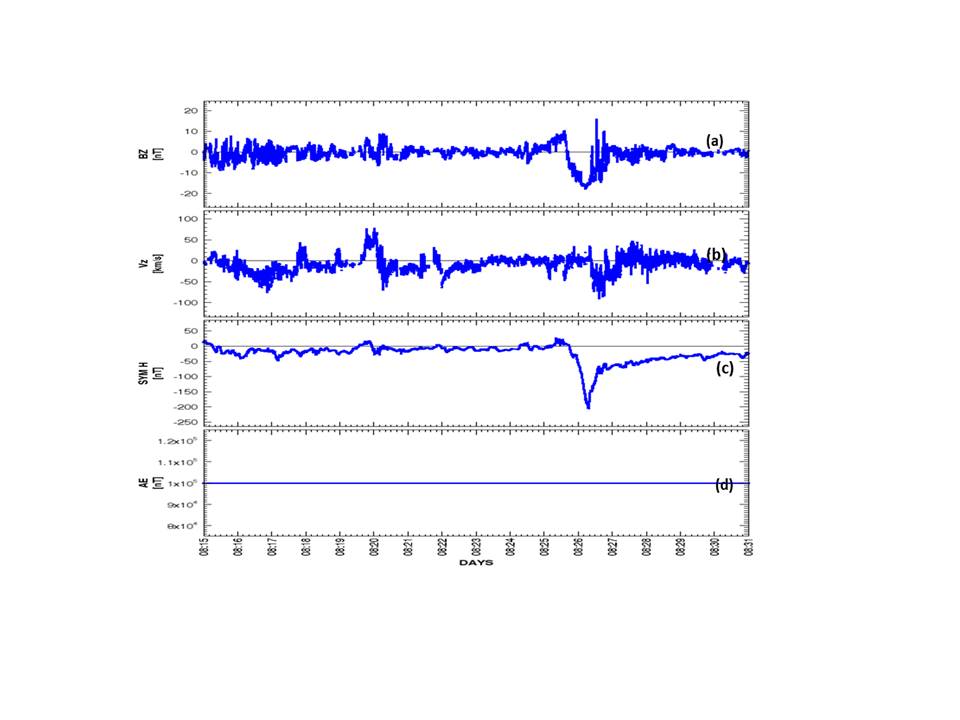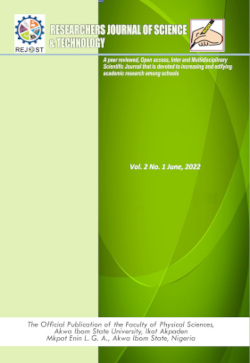Response of Magnetometer and GPS Data before two Strong Seismic events of 24th August, 2018 and 1st March, 2019 in Peru
Keywords:
Magnetometer, GPS, Peru, Earthquake, ResponseAbstract
Earthquakes (EQs) constitute serious natural environmental hazards threatening lives on earth and are capable of inducing large-scale disturbances in global ionospheric dynamics and related parameters.Presently, there is no doubt that multi-precursors analysis is a necessary step to better understand the mechanism before large earthquakes, however, the swiftness in response by the various devices has not been fully studied.In this study, we investigated the response of both the magnetometer and the Global Positioning System (GPS) - total electron content (TEC) data simultaneously from two strong seismic events that occurred on August 24, 2018 (M7.1) and March 1, 2019 (M7.0) in Peru to ascertain their responsiveness to these events. Both magnetometer and the Global Positioning System data were simultaneously acquired within the same period for each seismic event. Quiet and disturbed plots were generated and correlated for the respective equipment in each EQ. Interplanetary, solar and geomagnetic data were also downloaded during these periods for the different events. For the March 1st, 2019 EQ, the difference between quiet and disturbed solar quiet (sq) as obtained by the magnetometer ranged from 5 nT to 50 nT. The highest variations occurred on February 28 and March 4, 2019 while the least was recorded on March 6, 2019. Both sets of devices contemporaneously presented irregularities on February 26 and 27, 2019. However, with respect to the swiftness of response, the magnetometer responded in the morning (being swifter) between 7 and 11am while the GPS responded to the signals in the evening (17:00 hours). Also, the M7.1 August 24 2018 EQ, was investigated between August 17th and 30th. Findings revealed that only the magnetometer was able to respond to the signals on August 17th, 18th, 20th and 22nd, 2018 from this EQ, whereas the GPS had no response. Hence, in both studied EQs with different time windows, the magnetometer was more sensitive (being swifter) than the GPS in responding to the signals from the seismic events.
References
Akpan, A. E., Ibanga, J. I., George, N. J., Ekanem, A. M. (2019): Assessing Seismo-ionospheric disturbances using Vanuatu and Honshu earthquakes of March 25, 2007, employing Demeter and GPS data. Int J Environ Sci Technol Iran 16(11):7187–7196. https:// doi.org/10.1007/s13762-019-02339-x
Bolaji, O. S., Adimula, I. A., Adeniyi, J. O., Yumoto, K. (2013). Variability of Horizontal Magnetic Field Intensity Over Nigeria During Low Solar Activity. 91–103. https://doi.org/10.1007/s11038-012-9412-0.
Bolaji, O. S., et al. (2016). Solar quiet current response in the African sector due to a 2009 sudden stratospheric warming event, J. Geophys. Res. Space Physics, 121, doi: 10.1002/2016JA022857.
Chukwuma, V. U., Adekoya, B. J., Thomas, J. E., Emah, J. B. and Oloruntola, R. F. (2021). On the significance of requisite criteria in detecting pre-earthquake ionospheric precursors: a case study of the Tohoku earthquake of March 11, 2011 Acta Geophysica 69 (4), 1545-1566
Fashae, J. B., Bolaji, O. S., Rabiu, A. B., Ajani, O. O. and Fadiji, J. O. (2023). The Ionospheric Response to the 2013 SSW Event Over the Asian Australian Sector. Journal of Geophysical Research: Space Physics, 128(10), e2023JA031646.
Freund, F. (2011). Pre-earthquake signals: underlying physical processes. J. Asian Earth Sci. 41, 383–400.
Forbes, J. M., Palo, S. E. and Zhang, X. (2000). Variability of the ionosphere; J. Atmos. Sol.-Terr. Phys. 62 685 –693, https://doi.-org/10.1016/S1364-6826(00)00029-8.
Hasbi, A. M., Momani, M. A., Mohd, M. A., Misran, N., Shiokawa, K., Otsuka, Y., Yumoto, K. (2009). Ionospheric and geomagnetic disturbances during the 2005 Sumatran earthquakes Journal of Atmospheric and Solar-Terrestrial Physics Volume 71, Issues 17–18, December 2009, Pages 1992-2005
Hayakawa, M. and Molchanov, O. A. (2002): Seismo-Electromagnetics: Lithosphere-Atmosphere-Ionosphere Coupling. Tok-yo: Terra Scientific Publishing Company, Tokyo.
Ibanga, J. I., Akpan, A. E., George, N. J., Ekanem, A. M. and George, A. M. (2017). Unusual ionospheric variations before the strong Auckland Islands, New Zealand earthquake NRIAG; J. Astron. Geophys. 7(1) 149–154, https://doi.org/-10.1016/j.nrjag.2017.12.007.
Karia, S., Sarkar, S., Pathak, S., Sharma, A. K., Ranganath, H. and Gwal, A. K. (2013). Analysis of space- and ground-based parameters prior to an earthquake on 12 December 2009 https://doi.org/10.1080-/01431161.2013.827341
Kim, V. P. and Hegai, V. V. (1997): On possible changes in the midlatitude upper ionosphere before strong earthquakes. Journal of Earthquake Prediction Research, 6, 275-280.
Liu, Y., Li, Z., Fu, L., Wang, J., and Zhang, C. (2019). Studying the ionospheric responses induced by a geomagnetic storm in September 2017 with multiple observations in America. GPS Solutions, 24(1). doi:10.1007/s10291-019-0916-1.
Liu, J. Y., Chuo, Y. J., Shan, S. J., Tsai, Y. B., Pulinets, S. A. and Yu, S. B. ( 2004). Pre-earthquake ionospheric anomalies monitored by GPS TEC. Annals of Geophysics, 22, 1585-1593.
Ma, G., and Maruyama, T. (2003). Derivation of TEC and estimation of instrumental biases from GEONET in Japan. Annales de Geophysique, 21(10), 2083–2093. https://doi.org/10.5194/angeo-21-2083-2003.
Molchanov, O. A. and Hayakawa, M. (2008). Seismo- electromagnetics and related phenomena: History and latest results. Toyko: Terra Scientific Publishing Company.
Parrot, M. (1995). Use of satellites to detect seismo-electromagnetic effects, Main phenomenological features of ionospheric precursors of strong earthquakes. Advances in Space Research, 15(11), 1337–1347.
Pulinets, S. A., Legen, A. D., Gaivoronskaya, T. V., and Depuev, V.K. (2003). Main phenomenological features of ionospheric precursors of strong earthquakes. Journal of Atmospheric, Solar and Terrestrial Physics, 65, 1337–1347.
Pulinets, S. A. and Boyarchuk, K. A. (2004): Ionospheric Precursors of Earthquakes. Berlin:Springer, Verlag Publishers. Germany.
Pulinets, S. A. (1998): Seismic activity as a source of the ionospheric variability. Advances in Space Research 22 (6), 903 – 906.
Rabiu, A. B., Adimula, I. A., Yumoto, K., Adeniyi, J. O. and Maeda, G. (2009). Preliminary results from the magnetic field measurements using Magdas at Ilorin, Nigeria. Earth, Moon and Planets, 104(1–4), 173–179. https://doi.org/10.1007-/s11038-008-9290-7.
Rangarajan, G. (1989). Indices of Geomagnetic Activity. Geomagnetism, Vol. 3, p. 323 – 384
Revathi, R., Brahmanandan, P, Vishnun, T., Uma (2011). Possible prediction of earthquakes by utilizing multi precursor parameters in association with ground and satellite-based remote sensing techniques
Rishbeth, H. and Mendillo, M. (2001). Patterns of ionospheric variability; J. Atmos. Sol. Terr. Phys. 63 1661–1680, https://doi.-org/10.1016/S13646826(01)00036-0.
Thomas, J. E., George, N. J., Ekanem, A. M., Nathaniel, E. U. (2020a). Preliminary investigation of earth tremors using total electron content: a case study in parts of Nigeria. NRIAG J Astronomy Geophysics 9(1):220–225. https://-doi.org/10.1080/20909977.2020.1723866
Thomas, J. E., George, N. J., Ekanem, A. M., Akpan, A. E. (2020b). Ionospheric plasma variations afore the east of Kuril Islands earthquake of 13th January, 2007. Geological Behavior 4(1):42–46. https://doi.org/10.26480/gbr.01 .2020.42.46
Thomas, J. E., Ekanem, A. M., George, N. J., Akpan, A. E. (2021). Electron temperature and ion density perturbations prior to the M6.8 Eastern Honshu, Japan earthquake of July 23, 2008. J Earth Syst Sci. https://doi.org/10.1007/s12040-021-01645-8
Thomas, J. E., Ekanem, A. M., George, N. J., Akpan, A. E. (2023). Ionospheric perturbations: a case study of 2007 five major earthquakes using DEMETER data, Acta Geophysica, 1-12,
Thomas, J. E., George, N. J., Ekanem, A. M., Ekpenyong, N. E. (2019). Ionospheric induced plasma disturbances afore the m7. 9 east-ern Sichuan china earthquake of 12th may, 2008, International Journal of Advanced Geosciences, 7(2), 12-15https://doi.org/10.14419/ijag.v7i2.29980
Thomas, J. E, Ben, U. C. Ekanem, A. M. George, N. .J., Nathaniel, E. U. (2022): Seismo ionospheric anomalies before M7.2 Haiti earthquake of August 14, 2021, from GPS TEC Acta Geophysicahttps://doi.org/10.1007/s11600-022-00903-7
Thomas, J. E. (2021): Lithosphere-atmosphere -Ionosphere coupling fog Pre-, Co- and post earthquakes: a case study of Northern Mariana, USA earthquake of 31st October 2007. Res J Sci Technol 1(1):37–46
Thomas, J. E., Nathaniel, E. U., George, N. J., Ekanem, A. M., Akpan, S. S. (2024). Statistical analysis of detected ionospheric anomalies with earthquake magnitudes: A case study of the New Zealand earthquakes of March 4, 2021 Results in Earth Sciences 2, 100011
Tronin, A. A. (2002): Atmosphere-lithosphere Coupling Thermal anomalies on the Earth surface in seismic processes. In: Hayakawa M. and O. A. Molchanov (Eds.), Seismo - Electromagnetics: Lithosphere - Atmosphere -Ionosphere Coupling, TERRAPUB, Tokyo, 173-176p.
Wanliss, J. A. and Showalter, K. M. (2006): High resolution global storm index: Dst versus SYM-H. Journal of Geophysical Research https://doi.org/10.1029/2005JA011034

Downloads
Published
How to Cite
Issue
Section
License
Copyright (c) 2024 Researchers Journal of Science and Technology

This work is licensed under a Creative Commons Attribution-NonCommercial-NoDerivatives 4.0 International License.




